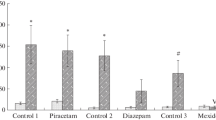Abstract
The purpose of the present study was: (1) to investigate the effects of unavoidable shock on an appetitively motivated discrimination task; (2) to evaluate the effect of chronic diazepam treatment on the performance of a previously learned discrimination task in shocked and nonshocked animals; (3) to measure the binding of 3H-flunitrazepam (an analogue of diazepam) to selected brain regions of chronically diazepam-treated shocked and nonshocked rats, in comparison to saline-treated controls. Results indicated that unavoidable shock significantly interfered with the learning of a new, nonshock-related discrimination task. The effect of chronic diazepam treatment on the performance depended on the previous experience of the animal; chronic diazepam treatment significantly improved the maze performance of shocked animals. On the other hand, chronic diazepam treatment in the nonshocked animals tended to interfere with the performance of the discrimination task. Neurochemical data showed significant reduction in 3H-flunitrazepam binding to diazepam receptors in membranes from the brains of a nonshocked diazepam-treated (CD) group in comparison to a nonshocked saline-treated (CS) group. In contrast, the unavoidable shock-treated diazepam group (SD) showed opposite effects, the binding of 3H-flunitrazepam increasing significantly. A significant increase in the maximal binding sites in the frontal cortex from shocked rats treated with diazepam, compared to the nonshocked diazepam-treated rats, was detected by Scatchard analysis.
Similar content being viewed by others
References
Anderson DC, Crowell C, Koehn D, Lupo JV (1976) Different intensities of unsignalled inescapable shock treatments as determinants of nonshock-motivated open field behavior: a resolution of disparate results. Physiol Behav 17:391–394
Barthalmus GT, Leander DJ, McMillan DE (1978) Combined effects of ethanol and diazepam on performance and acquisition of serial position sequences by pigeons. Psychopharmacology 59:101–102
Breastrup C, Nielson M, Nielsen EB, Lyon M (1979a) Benzodiazepine receptors in the brain as affected by different experimental stresses: the changes are small and not unidirectional. Psychopharmacology 65:273–277
Braestrup C, Nielsen M, Squires RF (1979b) No change in rat benzodiazepine receptors after withdrawal from continuous treatment with lorazepam and diazepam. Life Sci 24:344–350
Braud W, Wepman B, Russo D (1969) Task and species generality of the “helplessness” phenomenon. Psychon Sci 16:154–155
Chang RSL, Snyder SH (1978) Benzodiazepine receptors: labelling in intact animals with 3H-flunitrazepam. Eur J Pharmacol 48:213–218
Damm WH, Müller EW, Schlafer V, Wollert V (1978) [3H] flunitrazepam: its advantages as a ligand for the identification of benzodiazepine receptors in rat membranes. Res Commun Chem Pathol Pharmacol 22:597–600
Dantzer R (1977) Behavioral effects of benzodiazepines: a review. Biobehav Rev 1:71–86
Dinsmoor J (1958) Pulse duration and food deprivation in escape from shock training. Psychol Rep 4:531–534
Duka T, Hölt V, Herz A (1979) In vivo receptor occupation by benzodiazepines and correlation with the pharmacological effect. Brain Res 179:147–156
Dundee JW, Pandit SK (1972) Anterograde amnesic effects of pethidine, hyoscine, and diazepam in adults. Br J Pharmacol 44:140–144
Grimm VE, Samuel D (1976) The effects of dark isolation on the performance of a white-black discrimination task in the rat. Int J Neurosci 7:1–7
Grimm VE, Samuel D (1978) Effect of unavoidable shock on nonaversively motivated performance. Physiol Behav 21:877–881
Iwahara S (1977) Contributions from the animal laboratory — drug and response inhibition. Mod Probl Pharmacopsychiatry 12:59–76
Jensen RA, Martinez JL, Vasquez BJ, McGaugh JL (1979) Benzodiazepines alter acquisition and retention of an inhibitory avoidance response in mice. Psychopharmacology 64:125–126
Liljequist R, Mattila MJ (1979) Acute effects of temazepam and nitrazepam on psychomotor skills and memory. Acta Pharmacol Toxicol 44:364–369
Lippa AS, Klepner CA, Yinger L, Sano MC, Smith WV, Beer B (1979) Relationship between benzodiazepine receptors and experimental anxiety in rats. Pharmacol Biochem Behav 9:853–856
Maier SF (1970) Failure to escape traumatic shock: incompatible skeletal motor response or learned helplessness? Learn Motivat 1:157–170
Mohler H, Okada T, Enna SJ (1978) Benzodiazepine and neurotransmitter receptor binding in rat brain after chronic administration of diazepam or phenobarbital. Brain Res 156:391–395
Mowrer OH (1940) An experimental analysis of “regression” with incidental observations on “reaction formation”. J Abnorm Psychol 35:56–87
Overstreet DH, Yamamura HI (1979) Receptor alterations and drug tolerance. Life Sci 25:1865–1878
Padilla AM, Padilla C, Ketterer T, Giacalone D (1970) Inescapable shocks and subsequent escape/avoidance conditioning in goldfish. Carassius auratus. Psychon Sci 20:295–296
Rosenberg HC, Chiu TH (1979) Decreased 3H-diazepam binding in a specific response to chronic benzodiazepine treatment. Life Sci 24:803–808
Sahgal A, Iversen SD (1978) The effects of chlordiazepoxide on a delayed pair comparison task in pigeons. Psychopharmacology 59:57–64
Seligman MEP, Rosellini RA, Kozak MJ (1975) Learned helplessness in the rat: time course, immunization and reversibility. J Comp Physiol Psychol 88:542–547
Seward J, Humphrey GL (1967) Avoidance learning as a function of pretraining in the cat. J Comp Physiol Psychol 63:338–341
Author information
Authors and Affiliations
Rights and permissions
About this article
Cite this article
Grimm, V.E., Hershkowitz, M. The effect of chronic diazepam treatment on discrimination performance and 3H-flunitrazepam binding in the brains of shocked and nonshocked rats. Psychopharmacology 74, 132–136 (1981). https://doi.org/10.1007/BF00432679
Received:
Accepted:
Issue Date:
DOI: https://doi.org/10.1007/BF00432679




